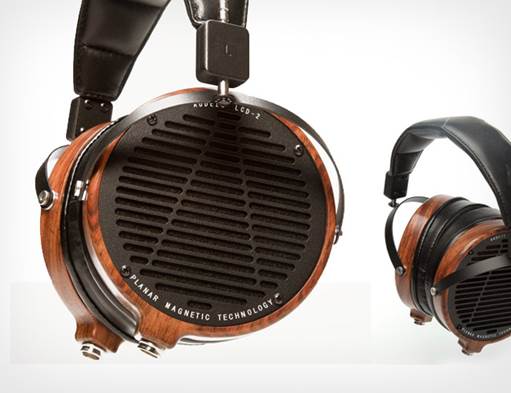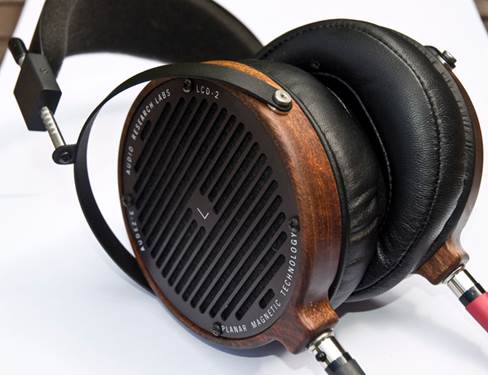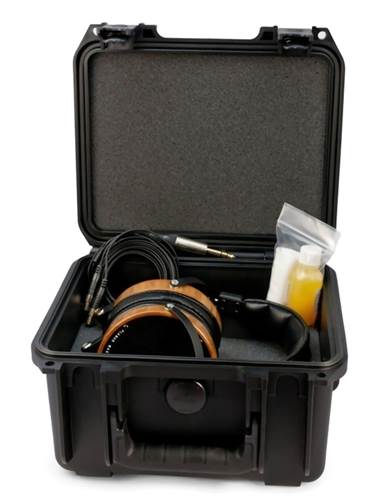If you thought the isodynamic
headphone was a curiosity from Hi-Fi’s past, think again. Modern magnetic
materials have given the concept an exciting new lease of life
Given that the isodynamic drive unit has
thrived in loudspeakers, most memorably in the giant Infinity IRS which
incorporated no fewer than 48 such drivers per channel, it’s odd that the
technology hasn’t enjoyed an equivalent status in headphones. Until recently,
reference to an isodynamic headphone would have cast my mind back 40 years to
the early 1970s’ Wharfedale Isodynamic – a headphone I lusted after as an
aspirant teenager but which did not spawn a host of imitators.

Audeze
LCD-2
Suddenly, though, the isodynamic headphone
is back in the news with well-received models appearing from both HiFiMAN and
Audeze, the latter a newcomer from the US that makes only isodynamic
headphones: the LCD-2 reviewed here and the more costly LCD-3, its top model.
Toe-dipping exercises these are not, with prices of $1,275 and $2,550
respectively, in the UK or $1,493 and $2,918 if bought online direct from
Audeze (before carriage, VAT, and import duty).
Low distortion
Sandwitched somewhere in between
moving-coil and electrostatic drive units, the isodynamic driver (also known as
orthodynamic or planar magnetic) uses opposed, like-pole bar magnets on either
side of a thin plastic diaphragm carrying a thin planar ‘voice coil’ etched on
its surface. With careful design, the magnetic field that bathes the long, thin
conductor is highly linear, giving the low distortion of an electrostatic unit
without the need for an external polarizing supply or signal step-up
transformer.
In the case of the LCD-2 there are 12
neodymium bar magnets per driver, six on either side of the diaphragm. Although
these make the plastic-ferrite magnets of the Whartfedale Isodynamic seem
positively archaic, they are still insufficient to gift the LCD-2 a sensitivity
that matches modern moving-coil designs. That is unlikely to be an issue, given
that Audeze makes no concessions for use with personal music players: a chunky
¼in jack plug is fitted at the end of the 2.5m connecting lead, with alternatives
available that provide for fully balanced drive via a 4-pin or two 3-pin XLRs,
for the few headphone amplifiers that are suitably equipped.
Not that you’d want to wear the LCD-2 on
the Tube, given that it weighs a substantial 600g and, with its large
circumaural capsules which don’t fold flat, would only fit in a pocket large
enough for poached rabbits. No, this is a headphone intended to sit beside your
favorite listening chair, for when private listening to your hi-fi system is
either demanded or preferred.

This
is a headphone intended to sit beside your favorite listening chair, for when
private listening to your hi-fi system is either demanded or preferred.
On the subject of the diaphragm material,
Audeze is coy in just saying that its Lotus diaphragm is not Mylar but uses
‘new materials’ for both the diaphragm and conductive traces. Its boasts that
the diaphragm can sustain temperatures exceeding 400oF (204oC) but given that
Wharfedale, all those years ago, used a NASA-developed polyimide that was
claimed to with stand as high as 400oC (752oF), this doesn’t seem particularly
remarkable.
Just as with leaf tweeters, isodynamic
headphone drivers are blessed with an input impedance that is almost
independent of frequency, which makes them uniquely tolerant of high source
impedance, even the 120ohm crazily recommended by the IEC. The Wharfedale’s
specified impedance was 120ohm  15%; the LCD-2’s is 60ohm.
15%; the LCD-2’s is 60ohm.
Audeze’s quoted sensitivity corresponds to
103dB for 1V – roughly 20dB lower than the most sensitive moving-coil
equivalents but a great deal more sensitive than isodynamic of yore.
Spacious quality
In practice the LCD-2 requires no special
provisions. I used it with the Lehmann Audio Black Cube Linear headphone
amplifier with ample gain in hand, and with the Bryston BHA-1 without the need
to engage the higher gain setting, which you would only need with programmer
material of exceptional dynamic range. Signals were provided by a Chord QuteHD
DAC fed S/PDIF from a TC Electronic Digital Konnekt x32 FireWire interface and
upstream Max mini running JRiver Media Center v17 under Windows XP.
Despite its weight and bulk, I also found
the LCD-2 comfortable to wear, not least due to its large, soft lambskin
leather circumaural earpads (faux leather alternatives are available) and
generous soft padding on the underside of the headband. Still, you notice the
difference when switching to a lighter headphone…

The
LCD-2 is supplied in an industrial plastic protective case and comes complete
with a wood care kit for polishing the bamboo or rosewood capsule trim
When we received the LCD-2 for review, I
had every expectation that it would challenge the Sennheiser HD 800 as my
favorite headphone to date, and not just because of the positive press it has
received. At the AES convention last October, a paper by Sean Olive and Todd
Welti described blind listening comparisons of six headphones, one of which was
the LCD-2. Although the test results were disguised by referring to them as
‘HP1’ to ‘HP6’, it is clear from the published frequency responses that ‘HP1’
was the LCD-2 – the model receiving by far the best subjective ratings from the
ten listeners.
But I’m going to demur somewhat from these
enthusiastic precedents. While the LCD-2 is a fine headphone with low
coloration and excellent bass, there’s a reticence to its makeup that not
everyone will appreciate. While it isn’t as lacking in sparkle as its
diffuse-filed corrected frequency response would indicate – fuelling a growing
suspicion in the industry that this correction is not optimal – nevertheless
this remains a distinct element of the LCD-2’s sonic makeup.
This was obvious the very first time I used
it, to listen to the Binaural+ recordings from Dr. Chesky’s Sensational,
Fantastic, and Simply Amazing Binaural Sound Show (24-bit/192kHz download from
HDtracks). The sound was smooth and spacious, and blessed with a remarkably
extended bass response that was not in the least over-egged. But it didn’t
quite have the frisson of live sound in a natural acoustic.
That wonderful bass was also in evidence
listening to a 24-bit/88.2kHz conversion of Peder af Ugglas’s ‘Beyond’, ripped
from the SACD release of the same name (Opus 3 CD 22072). The opening piano was
also less harsh in parts than is typically the case but the suppressed cymbal
sound was symptomatic of the LCD-2’s lushly-inclined tonal balance.